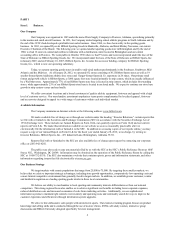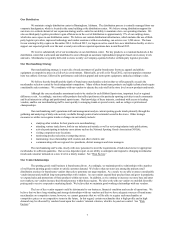Hibbett Sports 2012 Annual Report Download - page 19
Download and view the complete annual report
Please find page 19 of the 2012 Hibbett Sports annual report below. You can navigate through the pages in the report by either clicking on the pages listed below, or by using the keyword search tool below to find specific information within the annual report. 15
We face risk that financial institutions may fail to fulfill commitments under our committed credit facilities.
We have financial institutions that are committed to providing loans under our revolving credit facilities. With the current
financial environment and the instability of financial institutions, there is a risk that these institutions cannot deliver against these
obligations in a timely matter, or at all. If the financial institutions that provide these credit facilities were to default on their
obligation to fund the commitments, these facilities would not be available to us, which could adversely affect our liquidity and
financial condition. For discussion of our credit facilities, see “Liquidity and Capital Resources” in Item 7 and Note 5 to our
consolidated financial statements.
Risks Related to Ownership of Our Common Stock.
The market price of our common stock, like the stock market in general, is likely to be highly volatile. Factors that could
cause fluctuation in our common stock price may include, among other things:
actual or anticipated variations in quarterly operating results;
changes in financial estimates by investment analysts and our inability to meet or exceed those estimates;
additions or departures of key personnel;
market rumors or announcements by us or by our competitors of significant acquisitions, divestitures or joint
ventures, strategic partnerships, large capital commitments or other strategic initiatives; and
sales of our common stock by key personnel or large institutional holders.
Many of these factors are beyond our control and may cause the market price of our common stock to decline, regardless
of our operating performance.
Risks Related to Regulatory, Legislative and Legal Matters.
We operate in a number of jurisdictions. It can be cumbersome to fill needed positions and comply with labor laws and
regulations, many of which vary from jurisdiction to jurisdiction.
We are heavily dependent upon our labor force. We attempt to attract and retain an appropriate level of personnel in both
field operations and corporate functions. Our compensation packages are designed to provide benefits commensurate with our level
of expected service. However, within our retail and our distribution operations, we face the challenge of filling many positions at
wage scales that are appropriate to the industry and competitive factors. We operate in a number of jurisdictions which can make it
cumbersome to comply with labor laws and regulations, many of which vary from jurisdiction to jurisdiction. As a result of these
and other factors, we face many external risks and internal factors in meeting our labor needs, including competition for qualified
personnel, overall unemployment levels, prevailing wage rates, as well as rising employee benefit costs, including insurance costs
and compensation programs. We also engage third parties in some of our process such as delivery and transaction processing and
these providers may face similar issues. Changes in any of these factors, including a shortage of available workforce in areas in
which we operate, could interfere with our ability to adequately service our customers or to open suitable locations and could result
in increasing labor costs.
We cannot be assured that we will not experience pressure from labor unions or become the target of labor union campaigns.
While we believe we maintain good relations with our employees, we cannot be assured that we will not experience
pressure from labor unions or become the target of labor union campaigns. The potential for unionization could increase in the
United States if Congress passes federal legislation that would facilitate labor organization. The unionization of a significant portion
of our workforce could increase our overall costs at the affected locations and adversely affect our flexibility to run our business in
the most efficient manner to remain competitive or acquire new business. In addition, significant union representation would require
us to negotiate wages, salaries, benefits and other terms with many of our employees collectively and could adversely affect our
results of operations by increasing our labor costs or otherwise restricting our ability to maximize the efficiency of our operations.
Changes in federal, state or local law, or our failure to comply with such laws, could increase our expenses and expose us to legal
risks.
While businesses are subject to regulatory matters relating to the conduct of their business, including consumer protection
laws, consumer credit privacy acts, product safety regulations, advertising regulations, zoning and land use regulations, sales and use
tax laws, wage and hour regulations, workplace safety regulations, environmental laws (including measures related to climate
change, greenhouse gas emissions, soil and groundwater contamination and disposal of waste and hazardous materials) and the like,
certain jurisdictions have taken a particularly aggressive stance with respect to such matters and have stepped up enforcement,
including fines and other sanctions. An increasing regulatory environment could expose us to a challenging enforcement
environment or to third-party liability (such as monetary recoveries and recoveries of attorneys fees) and could have a material
adverse affect on our business and results of operations, including the added cost of increased preventative measures that we may
determine to be necessary to conduct our business in certain locales.
























